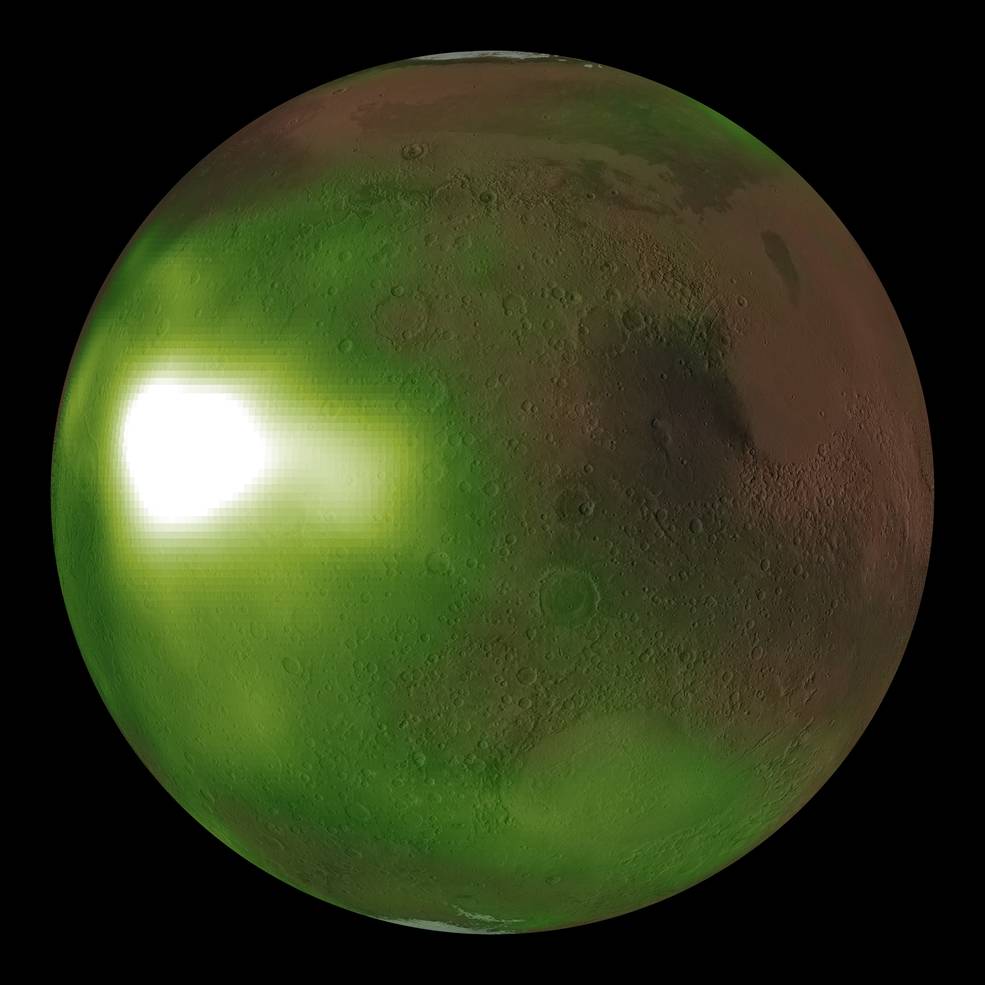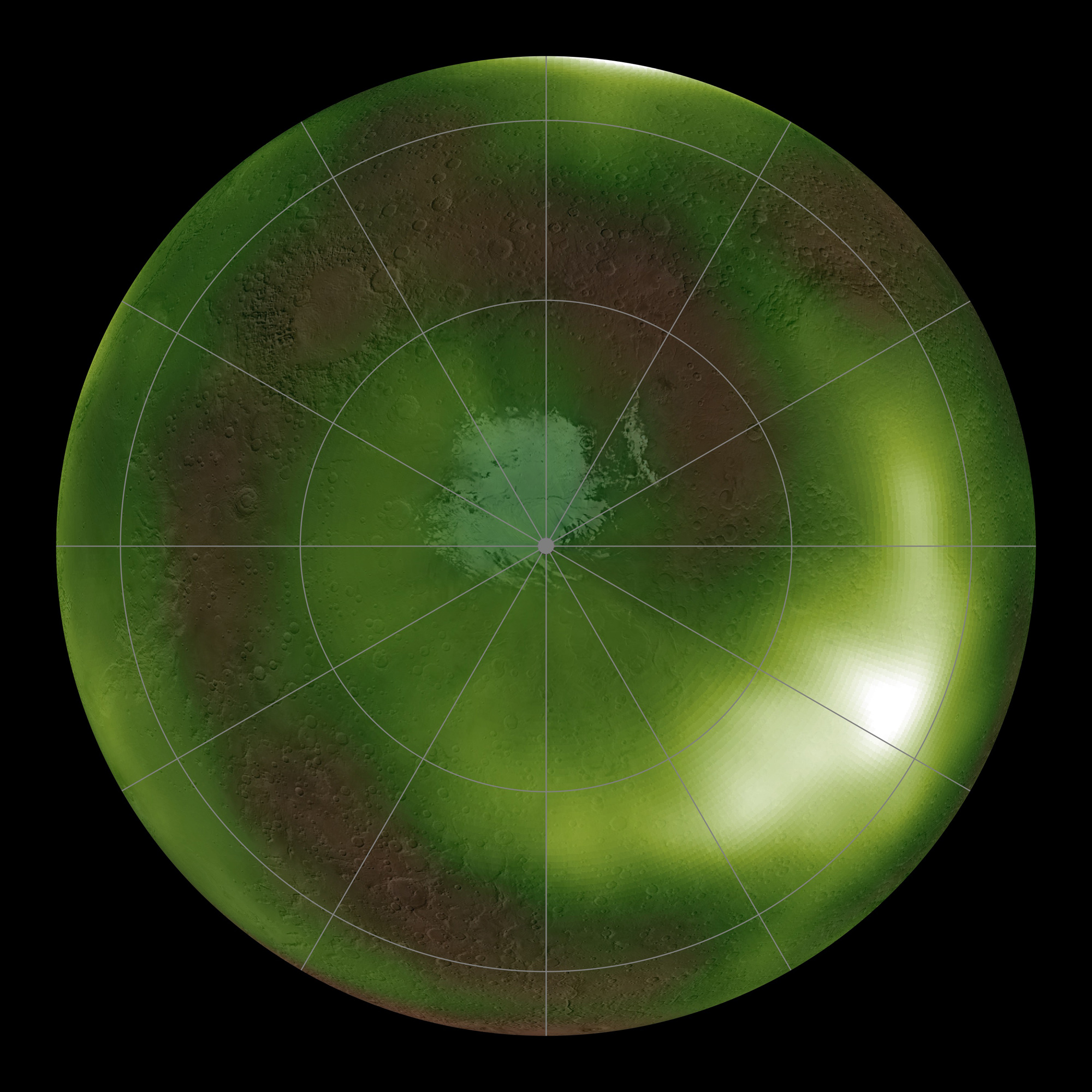The eerie green 'nightglow' of Mars pulses in ultraviolet light in new NASA views
New images of green, pulsing ultraviolet flashes of Mars' "nightglow" are illuminating circulation patterns in the Martian atmosphere.
NASA's Mars Atmosphere and Volatile Evolution mission (MAVEN for short), has been studying Mars since it launched to orbit and study the Red Planet in 2013. Now, new images from MAVEN have revealed the weird and unexpected inner workings of the planet's atmosphere.
"MAVEN's images offer our first global insights into atmospheric motions in Mars' middle atmosphere, a critical region where air currents carry gases between the lowest and highest layers," Nick Schneider, a professor of astrophysical and planetary sciences at the University of Colorado's Laboratory for Atmospheric and Space Physics (LASP) in Boulder, Colorado, said in a NASA statement. Schneider is also the instrument lead for the MAVEN Imaging Ultraviolet Spectrograph (IUVS) instrument that made these observations and lead author on the new study describing this work.
Related: The 7 biggest mysteries of Mars

These images revealed that Mars' atmosphere pulses exactly three times every night during spring and fall on the planet. The new observations also showed waves and spirals over the planet's winter polar regions. The MAVEN work also verified something the European Space Agency's (ESA) Mars Express spacecraft, which first found that "nightglow," or the planet's ultraviolet nighttime glow, is brightest over Mars' cold poles.
This bright glow is created when winds carry gases down to denser regions of the atmosphere. This movement speeds up a reaction that creates the nitric oxide responsible for the glow, which is only visible in ultraviolet light.

This ultraviolet glow "is as bright in the ultraviolet as Earth's northern lights," Zac Milby, a student researcher at LASP, said in the same statement. "Unfortunately, the composition of Mars' atmosphere means that these bright spots emit no light at visible wavelengths that would allow them to be seen by future Mars astronauts."
Get the Space.com Newsletter
Breaking space news, the latest updates on rocket launches, skywatching events and more!
The seasonal pulses that the team discovered additionally revealed that the number and speed of waves in the atmosphere are influenced by daily solar heating and volcanic activity on Mars. The pulses spotted by MAVEN show clearly how the waves in Mars' middle atmosphere match those in the other layers of the planet's atmosphere, according to the same statement.
"MAVEN's main discoveries of atmosphere loss and climate change show the importance of these vast circulation patterns that transport atmospheric gases around the globe and from the surface to the edge of space." Sonal Jain, a research associate at LASP, said in the statement.
This work was published on Aug. 6 in the Journal of Geophysical Research, Space Physics.
Email Chelsea Gohd at cgohd@space.com or follow her on Twitter @chelsea_gohd. Follow us on Twitter @Spacedotcom and on Facebook.
Join our Space Forums to keep talking space on the latest missions, night sky and more! And if you have a news tip, correction or comment, let us know at: community@space.com.

Chelsea “Foxanne” Gohd joined Space.com in 2018 and is now a Senior Writer, writing about everything from climate change to planetary science and human spaceflight in both articles and on-camera in videos. With a degree in Public Health and biological sciences, Chelsea has written and worked for institutions including the American Museum of Natural History, Scientific American, Discover Magazine Blog, Astronomy Magazine and Live Science. When not writing, editing or filming something space-y, Chelsea "Foxanne" Gohd is writing music and performing as Foxanne, even launching a song to space in 2021 with Inspiration4. You can follow her on Twitter @chelsea_gohd and @foxannemusic.










